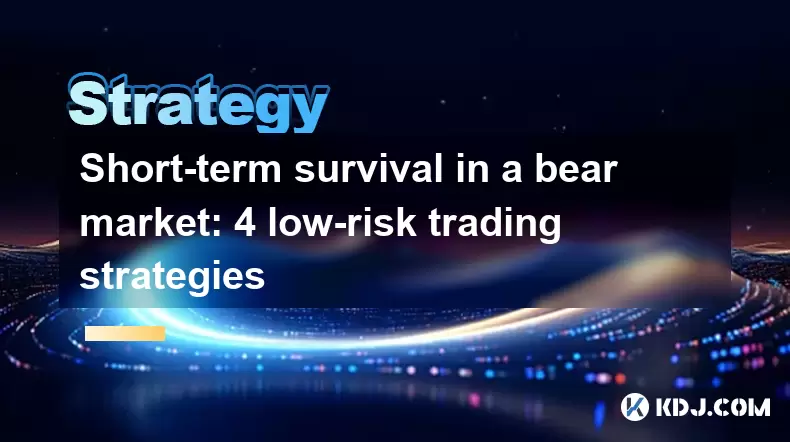-
 bitcoin
bitcoin $122288.232522 USD
0.16% -
 ethereum
ethereum $4480.662914 USD
-0.22% -
 xrp
xrp $2.962747 USD
-2.32% -
 tether
tether $1.000120 USD
-0.05% -
 bnb
bnb $1145.654223 USD
-2.07% -
 solana
solana $227.105217 USD
-1.67% -
 usd-coin
usd-coin $0.999548 USD
-0.02% -
 dogecoin
dogecoin $0.250875 USD
-2.04% -
 tron
tron $0.340654 USD
-0.49% -
 cardano
cardano $0.837968 USD
-2.52% -
 hyperliquid
hyperliquid $48.960449 USD
0.06% -
 chainlink
chainlink $22.049280 USD
-1.33% -
 ethena-usde
ethena-usde $1.000404 USD
0.02% -
 sui
sui $3.586212 USD
0.20% -
 avalanche
avalanche $29.894916 USD
-4.18%
Short-term survival in a bear market: 4 low-risk trading strategies
In a crypto bear market, employ low-risk strategies like dollar-cost averaging, hedging with stablecoins, trading options/futures, and staking/yield farming to thrive.
May 24, 2025 at 04:42 am

In the volatile world of cryptocurrencies, navigating a bear market can be particularly challenging. A bear market, characterized by a prolonged period of falling prices, can test the resilience of even the most seasoned traders. However, by employing low-risk trading strategies, it's possible to not only survive but potentially thrive during these downturns. This article explores four such strategies that can help you weather the storm of a bear market in the crypto space.
Strategy 1: Dollar-Cost Averaging (DCA)
Dollar-Cost Averaging is a strategy that involves investing a fixed amount of money at regular intervals, regardless of the market's performance. This approach helps mitigate the risk of investing a large sum at a peak price and can be particularly effective in a bear market.
- Choose your investment amount: Determine how much you can afford to invest regularly. This could be weekly, bi-weekly, or monthly.
- Select your cryptocurrency: Choose a cryptocurrency that you believe in for the long term. Popular choices include Bitcoin and Ethereum, but you might also consider other stablecoins.
- Set up automatic investments: Many cryptocurrency exchanges offer the option to set up recurring purchases. Automate your investments to ensure consistency.
- Monitor and adjust: While DCA is a set-and-forget strategy, it's still important to periodically review your investments and adjust your strategy if necessary.
By consistently investing over time, you'll buy more units of the cryptocurrency when prices are low and fewer when prices are high, ultimately reducing your average cost per unit.
Strategy 2: Hedging with Stablecoins
Hedging is another effective strategy for surviving a bear market. In the crypto world, one way to hedge is by using stablecoins, which are cryptocurrencies pegged to a stable asset like the US dollar.
- Identify your exposure: Determine which cryptocurrencies in your portfolio are most at risk during a bear market.
- Choose a stablecoin: Popular stablecoins include Tether (USDT), USD Coin (USDC), and DAI. Research and select one that suits your needs.
- Convert a portion of your holdings: Decide on a percentage of your portfolio to convert into stablecoins. This could be 20%, 30%, or whatever amount you feel comfortable with.
- Monitor market conditions: Keep an eye on the market and be ready to convert your stablecoins back into other cryptocurrencies when you see signs of recovery.
By holding stablecoins, you can protect a portion of your portfolio from the volatility of the bear market, providing a safety net that can be redeployed when conditions improve.
Strategy 3: Trading Options and Futures
For more experienced traders, trading options and futures can be a way to profit from a bear market. These financial instruments allow you to speculate on the future price of a cryptocurrency without actually owning it.
- Educate yourself: Before diving into options and futures, it's crucial to understand how they work. There are numerous resources available online, from beginner guides to advanced trading courses.
- Choose a platform: Select a reputable exchange that offers options and futures trading. Some popular platforms include Binance, Coinbase, and Deribit.
- Develop a strategy: Decide whether you want to go long (betting on a price increase) or short (betting on a price decrease). In a bear market, shorting can be particularly lucrative.
- Start small: Begin with small trades to get a feel for the market. As you gain confidence, you can gradually increase your position sizes.
- Use risk management tools: Set stop-loss orders to limit potential losses and take-profit orders to secure gains.
While trading options and futures can be risky, they offer the potential for significant profits in a bear market, provided you approach them with caution and a well-thought-out strategy.
Strategy 4: Staking and Yield Farming
Staking and yield farming are ways to earn passive income from your cryptocurrency holdings, which can be particularly valuable during a bear market when capital appreciation is less likely.
- Choose a staking platform: Many exchanges and decentralized finance (DeFi) platforms offer staking services. Research and select one that offers competitive rewards.
- Select your cryptocurrency: Not all cryptocurrencies can be staked. Popular options include Ethereum 2.0, Cardano (ADA), and Tezos (XTZ).
- Lock your tokens: Transfer your chosen cryptocurrency to the staking platform and lock it for a specified period. The length of the lock-up period can vary, so choose one that aligns with your investment horizon.
- Monitor your rewards: Staking rewards are typically distributed periodically. Keep track of your earnings and reinvest them if you wish to compound your returns.
- Explore yield farming: For more advanced users, yield farming involves lending your cryptocurrencies to liquidity pools in DeFi platforms. This can offer higher yields but comes with increased risk.
By staking or yield farming, you can generate a steady stream of income that can help offset any losses incurred during a bear market.
FAQs
Q1: Can these strategies be used in a bull market as well?While these strategies are particularly effective in a bear market, some can also be beneficial in a bull market. For example, dollar-cost averaging can help you buy into a rising market without trying to time the market perfectly. Hedging with stablecoins can provide a safety net against sudden downturns, even during a bull run. However, strategies like shorting through options and futures are generally more suited to bear markets.
Q2: How much of my portfolio should I allocate to these strategies?The allocation depends on your risk tolerance and investment goals. A common approach is to allocate a portion of your portfolio to more conservative strategies like DCA and staking, while reserving a smaller percentage for higher-risk strategies like options and futures trading. A balanced approach might be to allocate 50-70% to low-risk strategies and 30-50% to higher-risk ones.
Q3: Are these strategies suitable for beginners?Some strategies, like dollar-cost averaging and staking, are relatively straightforward and can be suitable for beginners. However, trading options and futures, as well as yield farming, require a deeper understanding of the market and come with higher risks. Beginners should start with the more conservative strategies and gradually move to more complex ones as they gain experience.
Q4: How long should I expect a bear market to last?The duration of a bear market can vary widely and is difficult to predict. Some bear markets last a few months, while others can extend to a year or more. It's important to focus on strategies that can help you navigate the market regardless of its duration, rather than trying to predict when it will end.
Disclaimer:info@kdj.com
The information provided is not trading advice. kdj.com does not assume any responsibility for any investments made based on the information provided in this article. Cryptocurrencies are highly volatile and it is highly recommended that you invest with caution after thorough research!
If you believe that the content used on this website infringes your copyright, please contact us immediately (info@kdj.com) and we will delete it promptly.
- BlockDAG, DOGE, HYPE Sponsorship: Crypto Trends Shaping 2025
- 2025-10-01 00:25:13
- Deutsche Börse and Circle: A StableCoin Adoption Powerhouse in Europe
- 2025-10-01 00:25:13
- BlockDAG's Presale Buzz: Is It the Crypto to Watch in October 2025?
- 2025-10-01 00:30:13
- Bitcoin, Crypto, and IQ: When Genius Meets Digital Gold?
- 2025-10-01 00:30:13
- Stablecoins, American Innovation, and Wallet Tokens: The Next Frontier
- 2025-10-01 00:35:12
- NBU, Coins, and Crypto in Ukraine: A New Yorker's Take
- 2025-10-01 00:45:14
Related knowledge

Practical parameter settings for a Bitcoin multi-timeframe moving average system
Sep 18,2025 at 10:54pm
Optimizing Timeframe Combinations for Bitcoin Trading1. Selecting appropriate timeframes is crucial when building a multi-timeframe moving average sys...

How can I filter out false breakouts in Dogecoin high-frequency trading?
Sep 22,2025 at 01:00am
Understanding False Breakouts in Dogecoin Trading1. A false breakout occurs when Dogecoin's price appears to move beyond a defined support or resistan...

Techniques for identifying tops and bottoms in the Bitcoin on-chain NVT model
Sep 20,2025 at 07:54pm
Understanding the NVT Model in Bitcoin Analysis1. The Network Value to Transactions (NVT) ratio is often described as the 'P/E ratio' of the cryptocur...

What does the surge in open interest in Bitcoincoin futures mean?
Sep 20,2025 at 11:18pm
Understanding the Surge in Dogecoin Futures Open Interest1. A surge in open interest within Dogecoin futures indicates a growing number of active cont...

How can I use the Ethereum USDT premium to gauge market sentiment?
Sep 18,2025 at 11:55pm
Understanding the Ethereum USDT Premium1. The Ethereum USDT premium refers to the price difference between USDT (Tether) traded on Ethereum-based plat...

What should I do if Ethereum staking yields decline?
Sep 20,2025 at 06:18am
Understanding the Causes Behind Declining Ethereum Staking Yields1. The Ethereum network transitioned to a proof-of-stake consensus mechanism with the...

Practical parameter settings for a Bitcoin multi-timeframe moving average system
Sep 18,2025 at 10:54pm
Optimizing Timeframe Combinations for Bitcoin Trading1. Selecting appropriate timeframes is crucial when building a multi-timeframe moving average sys...

How can I filter out false breakouts in Dogecoin high-frequency trading?
Sep 22,2025 at 01:00am
Understanding False Breakouts in Dogecoin Trading1. A false breakout occurs when Dogecoin's price appears to move beyond a defined support or resistan...

Techniques for identifying tops and bottoms in the Bitcoin on-chain NVT model
Sep 20,2025 at 07:54pm
Understanding the NVT Model in Bitcoin Analysis1. The Network Value to Transactions (NVT) ratio is often described as the 'P/E ratio' of the cryptocur...

What does the surge in open interest in Bitcoincoin futures mean?
Sep 20,2025 at 11:18pm
Understanding the Surge in Dogecoin Futures Open Interest1. A surge in open interest within Dogecoin futures indicates a growing number of active cont...

How can I use the Ethereum USDT premium to gauge market sentiment?
Sep 18,2025 at 11:55pm
Understanding the Ethereum USDT Premium1. The Ethereum USDT premium refers to the price difference between USDT (Tether) traded on Ethereum-based plat...

What should I do if Ethereum staking yields decline?
Sep 20,2025 at 06:18am
Understanding the Causes Behind Declining Ethereum Staking Yields1. The Ethereum network transitioned to a proof-of-stake consensus mechanism with the...
See all articles










































































